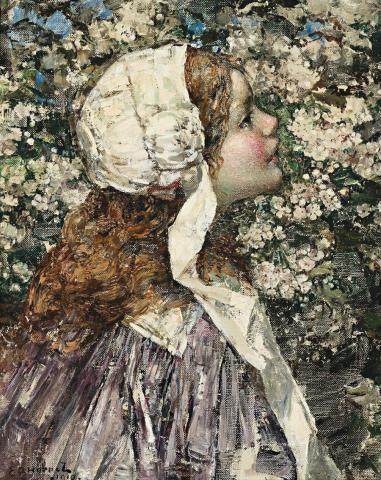GIRL IN SPRING BLOSSOMS, 1910
EDWARD ATKINSON HORNEL
oil on canvas
51.0 x 41.0 cm
signed and dated lower left: E A Hornel / 1910
Sotheby's, Melbourne, 22 April 1991, lot 214
Deutscher Fine Art, Melbourne
Philip Bacon Galleries, Brisbane (label attached verso)
Private collection, Brisbane
Deutscher~Menzies, Sydney, 13 June 2007, lot 17
Private collection, New South Wales
Born of Scottish parents in Bacchus Marsh, Victoria, Edward Hornel, moved to Scotland at the age of two and settled with his family in the 'artists' town' of Kirkcudbright in 1866. He studied at the art school in Edinburgh for three years followed by the Fine Arts Academy in Antwerp, the second oldest art school in Europe, under the director Charles Verlat. Vincent Van Gogh attended the Academy in 1885-86.
An early influence on Hornel's work was the French artist Adolphe Monticelli whose pictures were shown at the Edinburgh International Exhibition in 1886. Monticelli had developed a highly individual romantic style of painting, richly coloured, dappled and textured.
On his return to Antwerp in 1885 Hornel met George Henry who introduced him to James Guthrie and other 'Glasgow Boys' Joseph Crawhall, John Lavery and William Macgregor, as well as Bessie MacNicol, the only female artist closely associated with the group. Hornel and Henry collaborated on The Druids Bringing in the Mistletoe 1890 which was shown in Munich and 'took Europe by storm'.1 This was a painting in which the decorative elements of incised gesso and overlaid gold co-existed with Celtic mythology. Both artists spent over a year together in Japan 1893-94.
The Glasgow Boys' main influences were that of Japanese Orientalism and the new French realism of Jules Bastien-Lepage. Their later works were often symbolist in style. They used gold paint, pre-dating Klimt, and anticipated Charles Rennie Mackintosh through the use of single female figures and a love of pattern.
Girl in Spring Blossoms 1910 clearly shows Hornel's interest in rich and atmospheric colour, dense pattern and fresh textured surface creating a sensuous and poetic subject.
1. Quoted from www.culture24.org.uk online exhibition review of The Glasgow Boys 1880-1900, Kelvingrove Art Gallery and Museum, Glasgow, interview with exhibition curator Jean Walsh
